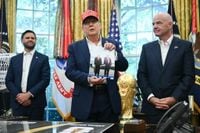US President Donald Trump has never been shy about touting his achievements, but his claims in August 2025 to have "solved six wars in six months"—and, elsewhere, "ended seven wars in seven months"—have drawn scrutiny from experts, journalists, and diplomats worldwide. The Conversation and other outlets, including The Guardian and Washington Post, have rigorously analyzed these assertions, finding that while Trump’s administration did play roles in various international crises, the reality is far more nuanced than the headlines suggest.
Trump’s approach to foreign policy has always been transactional and high-profile, favoring dramatic gestures and bold pronouncements. His supporters, and even some foreign officials, have lauded him as a master dealmaker. Yet, as Rachael Jolley and Sam Phelps of The Conversation point out, a closer look reveals that many of these so-called "peace deals" were, at best, temporary ceasefires or fragile diplomatic frameworks, not the resolution of deep-rooted conflicts.
Take, for example, the India-Pakistan conflict in May 2025. Tensions flared after a terrorist attack in Indian-controlled Kashmir and a subsequent military campaign dubbed "Operation Sindoor." Trump claimed to have averted "a possible nuclear disaster" by brokering a truce. However, Natasha Lindstaedt, a professor at the University of Essex, told The Conversation that both India and Pakistan publicly denied any US role in the ceasefire. "They were very clear that they reached an agreement on May 7 with no third party intervention," she explained. While Pakistan’s leadership credited the US with behind-the-scenes pressure, India insisted the resolution was bilateral and not the result of Trump’s intervention.
This pattern—Trump claiming credit for de-escalations that others attribute to local actors—repeats itself across several conflicts. In the case of the Thailand-Cambodia border dispute in July 2025, Petra Alderman of the London School of Economics acknowledged that Trump’s threat to suspend trade talks did push both countries toward a ceasefire. The conflict, which claimed over 33 lives and displaced hundreds of thousands, was de-escalated when economic interests took precedence. "Securing a trade deal with the US took precedence over the border conflict but did nothing to resolve its root causes," Alderman cautioned. The ceasefire, while welcome, left the underlying territorial and nationalist grievances unresolved, meaning future flare-ups remain a real possibility.
Trump’s intervention in the Democratic Republic of Congo and Rwanda’s decades-long conflict also drew skepticism. Jonathan Beloff of King’s College London stressed that the US-brokered agreement in 2025 was vague and did not address fundamental issues like governance failures or economic instability in the DRC. "He did not end the war, but at best stalled the conflict for now," Beloff said. The deal, he argued, was more about appeasing Trump than achieving lasting peace. Even the main M23 rebel group, backed by Rwanda, soon rejected the terms, highlighting the fragility of any diplomatic progress.
The Kosovo-Serbia situation presented another case of ambiguous achievement. While Trump’s administration brokered an economic normalization agreement in 2020, Stefan Wolff of the University of Birmingham noted that the significance of any 2025 intervention was unclear. "If there really was something significant [in 2025], there would be more evidence," he told The Conversation. The deep-seated issues between Kosovo and Serbia remain unresolved, and the region continues to experience periodic tensions.
Perhaps the most high-profile of Trump’s recent diplomatic efforts was the peace framework between Armenia and Azerbaijan, reached in early August 2025. Ayla Göl of York St. John University described the deal as a "historic milestone" on paper, but pointed out its limitations. The agreement included the creation of a transit corridor—dubbed the Trump Route for International Peace and Prosperity—connecting Azerbaijan to its exclave of Nakhchivan via Armenia, with the US granted exclusive development rights for up to 99 years. Yet, the framework lacked concrete plans for the return of over 100,000 Armenian refugees displaced from Nagorno-Karabakh. Moreover, Azerbaijani demands for constitutional changes in Armenia threatened to derail the process, while neighboring Iran viewed the corridor as a strategic threat. "The Trump route could strengthen American security commitments in the region or create new geopolitical competition," Göl warned. The peace deal, while a step forward, was not yet signed and faced significant hurdles.
The Israel-Iran conflict of June 2025 offers another telling example. Hostilities erupted after Israeli strikes on Iranian facilities, derailing ongoing US-Iran negotiations. Trump intervened after 12 days, urging Israeli Prime Minister Benjamin Netanyahu to limit the strikes. Scott Lucas of University College Dublin observed that the ceasefire was the result of multiple actors, including Qatar and France, working behind the scenes. "You can’t claim credit for ending a war when you helped escalate that war in the first place," Lucas said. Both Israel and Iran were motivated to de-escalate for strategic reasons, not solely because of US intervention.
Other conflicts, such as the Ethiopia-Egypt dispute over the Grand Ethiopian Renaissance Dam, further illustrate the gap between Trump’s rhetoric and reality. Despite claims of having brought "peace at least for now," no binding agreement was reached, and tensions persist.
Critics argue that Trump’s penchant for equating ceasefires with true peace not only overstates his achievements but also obscures the complex, painstaking work required to resolve the root causes of international disputes. As The Guardian noted, these temporary pauses in fighting are not synonymous with lasting peace. "A ceasefire is not peace. True peace requires addressing the root causes of conflict—territorial disputes, ideological rifts, and resource scarcity—and securing the commitment of all parties involved, not just a temporary pause in violence," one analysis concluded.
Trump’s supporters, meanwhile, celebrate the optics of high-profile summits and signing ceremonies, often overlooking the fragility of the arrangements. The chasm between political promise and geopolitical reality is perhaps most evident in the ongoing war in Ukraine. Despite bold declarations that he could end the conflict in days, Trump’s diplomatic efforts have yet to yield a breakthrough, and the war continues to rage.
Ultimately, while Trump’s administration has contributed to several diplomatic de-escalations, expert analysis from The Conversation and other outlets finds his claims to have "solved" multiple wars in record time to be, at best, exaggerations. The world’s most intractable conflicts remain unresolved, and the difference between a ceasefire and true peace is one that both history and current events refuse to ignore.

